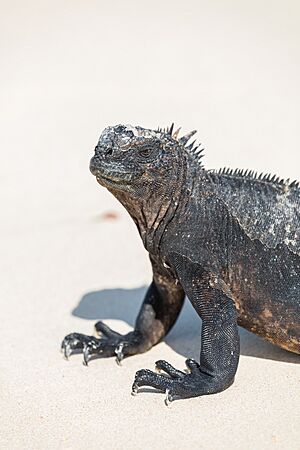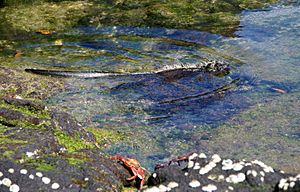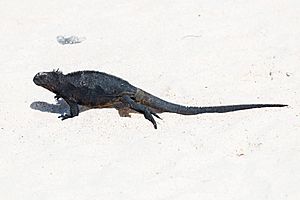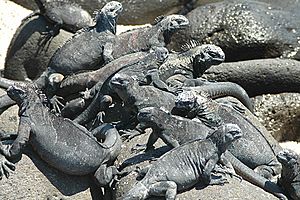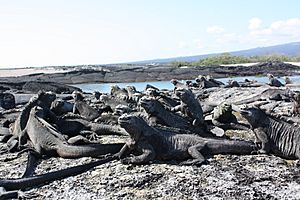Marine iguana facts for kids
Quick facts for kids Marine iguana |
|
|---|---|
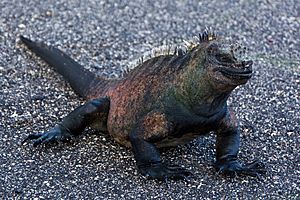 |
|
| Scientific classification | |
| Kingdom: | |
| Class: | |
| Order: | |
| Family: |
Iguanidae
|
| Genus: |
Amblyrhynchus
|
| Binomial name | |
| Amblyrhynchus cristatus |
|
The marine iguana (Amblyrhynchus cristatus) is a special type of iguana that lives only on the Galápagos Islands. It's the only modern lizard that can swim and find its food in the sea, making it a true marine reptile. These amazing iguanas can dive more than 9 meters (30 feet) deep!
You can find marine iguanas on all the islands in the archipelago. Sometimes, people call them the Galápagos marine iguana. They mostly live on the rocky shores of the Galápagos. This helps them warm up after swimming in the cold ocean. You might also spot them in marshy areas or on mangrove beaches.
Contents
Different Types of Marine Iguanas
There are several different types, or subspecies, of marine iguanas. Each type lives on a specific island or group of islands in the Galápagos. They can look a bit different depending on where they live.
- A. c. albemarlensis – Found on Isabela Island
- A. c. cristatus – Found on Fernandina Island
- A. c. hassi – Found on Santa Cruz Island
- A. c. mertensi – Found on San Cristóbal and Santiago Islands
- A. c. nanus – Found on Genovesa Island
- A. c. sielmanni – Found on Pinta Island
- A. c. venustissimus – Found on Española Island (and nearby tiny Gardener Island)
What Marine Iguanas Look Like and Do
When Charles Darwin visited the islands, he saw these iguanas. He thought they looked a bit strange! He wrote that they were "disgusting clumsy Lizards" and called them "imps of darkness." But he also noted how well they fit into their rocky home.
Marine iguanas are medium-sized lizards. Adults are usually about 20 to 34 centimeters (8 to 13 inches) long from their snout to their tail base. They are unique because they are the only lizards that feed only on algae found in the ocean. Because they swim in cold water, they have special ways to control their body temperature.
Marine iguanas are not always black. Young iguanas have a lighter stripe on their back. Some adults are grey. Adult males can even change color with the seasons! Their dark color helps them warm up quickly after being in the cold water. This is important because they are slow and clumsy on land when they are cold.
Even though they are slow on land, marine iguanas are amazing swimmers. Their flat tail helps them push through the water. Their spiky fin on their back also helps them move. They have long, sharp claws that let them hold onto rocks, even in strong ocean currents.
Body Size and Life Span
The size of marine iguanas changes depending on which island they live on. The biggest iguanas are found on Fernandina and Isabela islands. The smallest ones live on Genovesa Island.
Adult males can weigh from about 12 to 13 kilograms (26 to 29 pounds) on southern Isabela. On Genovesa, they might only weigh 1 to 2 kilograms (2 to 4 pounds). This difference in size is because of how much algae (their food) is available and how warm the ocean water is around each island.
Male marine iguanas are usually much bigger than females, weighing about 70% more. Being big can be good for males when trying to find a mate. However, during times when food is scarce, like during El Niño events, bigger males might struggle more to find enough food. This means that large males sometimes don't live as long as females or smaller males during tough times.
Reproduction and Life Cycle
Marine iguanas start their breeding season when the weather is cold and dry. Female iguanas are ready to have babies when they are 3 to 5 years old. Males are ready a bit later, at 6 to 8 years old.
A female usually lays two or three eggs, but sometimes she can lay between one and six. The eggs are white and have a leathery shell. They are quite large for an iguana, measuring about 9 by 4.5 centimeters (3.5 by 1.8 inches). All the eggs together can weigh up to a quarter of the mother's body weight!
The eggs hatch after about three months. The mother digs a nest 30 to 80 centimeters (12 to 31 inches) deep in sand or volcanic ash to keep them safe.
What Marine Iguanas Eat
Marine iguanas eat only algae that grows in the ocean. They especially like 4 or 5 types of red algae. However, when their favorite red algae isn't easy to find, like during very low tides, they will eat green algae, which they usually avoid.
Their diet changes based on how much algae is available and what kind they prefer. Only about 5% of marine iguanas dive deep into the ocean for food. These are usually the large males. Diving helps them avoid competing for food with smaller males and females, who can only feed during low tide.
Their feeding habits also change with the seasons. They become better at finding food when the water is warmer. Sometimes, food can be hard to find. This has made marine iguanas very good at finding food to get enough energy. For example, during an El Niño event when food was scarce for two years, some iguanas actually shrank by up to 20% in length! When food became normal again, they grew back to their original size. Scientists think their bones might actually shorten during these times.
The marine iguana's body is also perfectly built for its diet. They have blunt snouts and sharp teeth to scrape algae off rocks. They also have special glands near their nose. These glands filter out extra salt from their blood, which they get from eating salty seaweed. They "sneeze" out this salt, which often leaves white patches on their faces.
Behavior and Habits
Marine iguanas are cold-blooded animals. This means their body temperature changes with their surroundings. After diving in the cold ocean for food, they need to warm up in the sun. Until they are warm, they can't move very well. This makes them easy targets for predators. However, they can act very aggressively, biting and bluffing, when they are in this vulnerable state. Their dark skin helps them soak up the sun's heat quickly.
During the breeding season, male iguanas sometimes fight. These fights are usually not harmful. Males will bob their heads as a warning. If another male responds, they will push their heads together until one of them gives up and walks away.
How Marine Iguanas Evolved
Scientists believe that land iguanas and marine iguanas came from a common ancestor. This ancestor likely arrived on the islands from South America, perhaps by floating on rafts of plants. The marine iguana became a separate species from the land iguana about 8 million years ago. This is even older than the current Galápagos islands! So, it's thought that their ancestors lived on parts of the volcanic islands that are now underwater.
Even though they are different species, marine iguanas and land iguanas can still have babies together. Sometimes, they hybridize (mix) where their homes overlap.
The different types of marine iguanas can be told apart by their size and colors. For example, the iguanas on Española Island are redder, while those on Santiago Island are greener.
The light color you sometimes see on their faces is actually salt! It comes from special glands near their nose. They "sneeze" out this extra salt, which then dries on their faces. This adaptation helps them get rid of the salt they eat from marine algae.
Marine iguanas have developed many special features to live in the ocean. They have blunt noses for eating seaweed, strong legs and claws for climbing and holding onto rocks, and flat tails for swimming. Compared to the land iguana, their front leg bones are heavier and more solid. This extra weight helps them dive underwater.
Sadly, marine iguanas don't have natural defenses against new predators that humans brought to the islands. Rats eat their eggs, cats hunt young iguanas, and dogs can threaten adult iguanas.
Images for kids
-
While feeding underwater, marine iguanas are sometimes cleaned by fish, like this Cortez rainbow wrasse. This iguana is on a rock covered in green and red algae.
-
Lava lizards often run over marine iguanas while hunting flies; the iguanas usually don't mind.
-
A marine iguana swimming in the sea near Puerto Ayora, the biggest town in the Galápagos.
See also
 In Spanish: Iguana marina para niños
In Spanish: Iguana marina para niños


